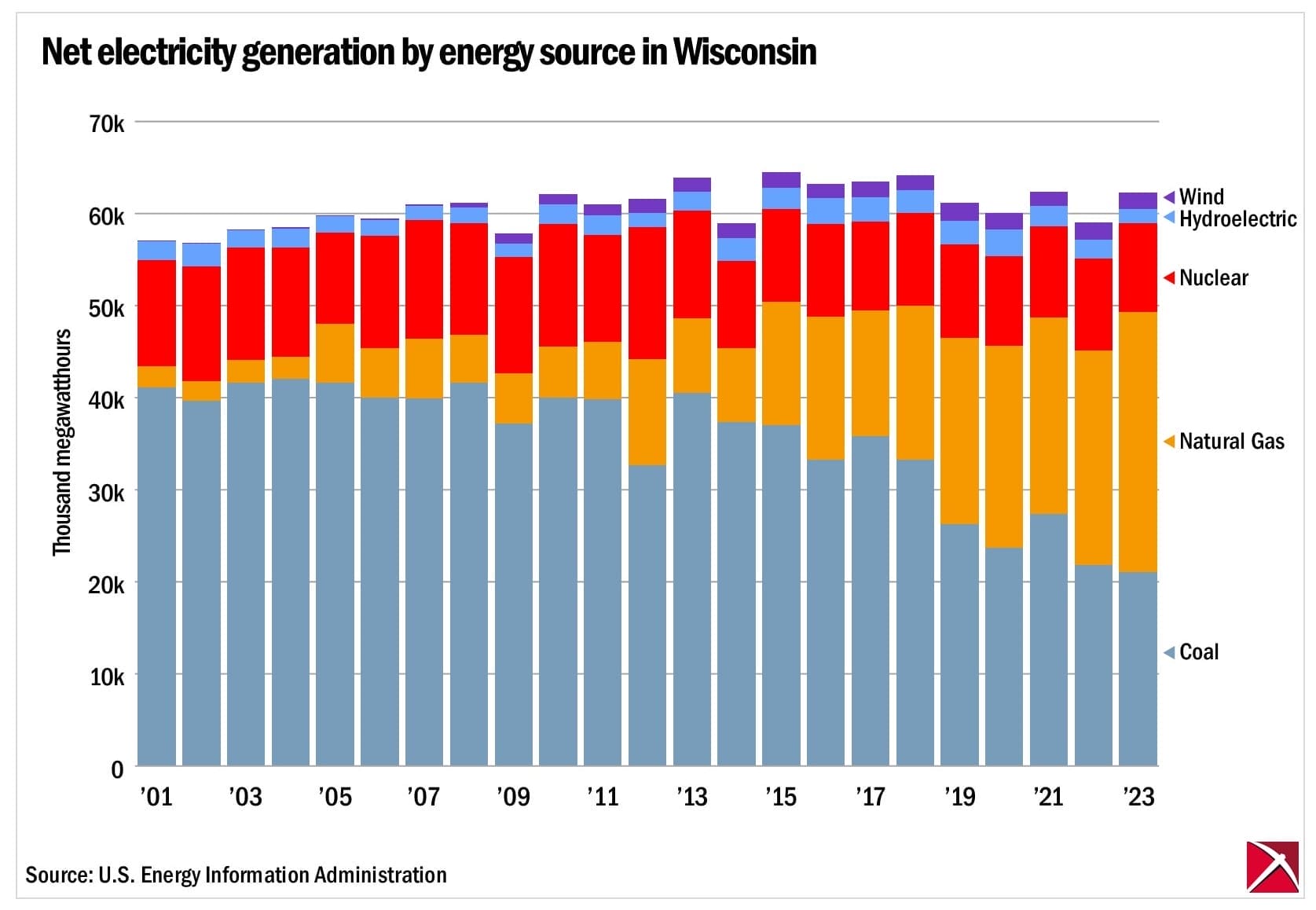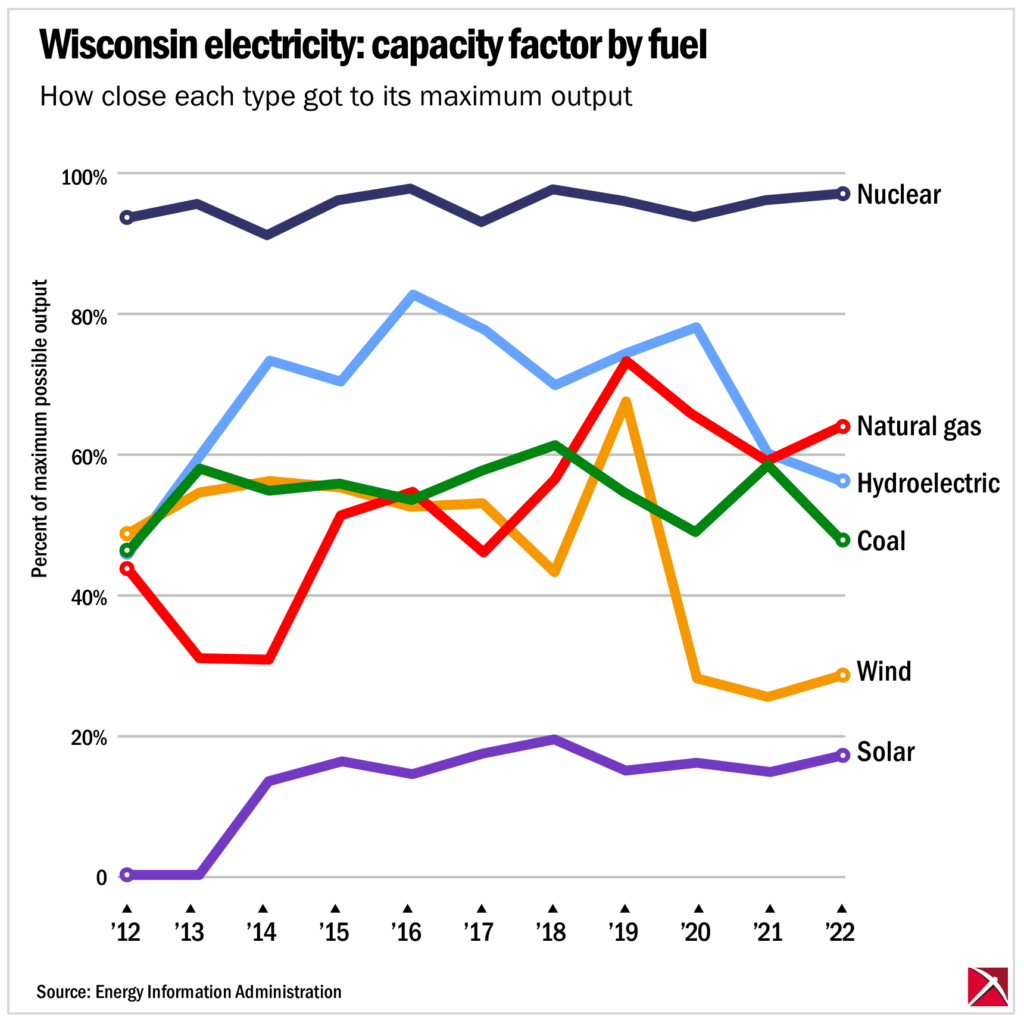This post originally appeared at https://www.badgerinstitute.org/why-support-a-pro-nuclear-resolution/
Facts for Wisconsin citizens and legislators
Situation now
Nuclear provides 16% of all electricity generated in Wisconsin. Down from 24% in 1990.
- Coal: Down from 69% in 1990 to 34% now.
- Gas: 1% in 1990 to 41% now.
- Wind: 2% in 2009, 3% now.
- Solar: 0% in 2019, 2% now.
Nuclear is the most reliable source of electricity, producing about 96% of the plant’s rated output.
Wisconsin wind turbines average about one-fourth of their rated capacity. Solar averages a little under 20%. Both are by nature intermittent: available when wind blows or sun shines.
Both, especially solar, also face land-use problems, especially regarding wildlife habitat.
Expected demand
Wisconsin electricity use up 33% since 1990 but flat since 1999.
Use likely will rise as power-intense data centers are built.
Wisconsin also is trying to incent the adoption of electric vehicles and electric appliances, increasing electricity demand.
Regional grid operator MISO forecast that it would be short of electricity at next summer’s peak by as much as 3,700 megawatts, or three times the output of Point Beach.
Wisconsin relies on imports via the regional grid for about 15% of its electricity.
Nuclear future
Bipartisan interest:
- Biden administration analyzed existing plant sites for potential new capacity, including Kewaunee, Point Beach.
- Michigan Legislature and governor agreed to restart recently closed Palisades plant.
New technology: “Small modular reactors,” manufactured off-site, may be faster and cheaper to build.
- Dairyland Power Co-op announced in 2022 it’s considering SMRs and confirmed that in late 2024 to us.
Spent fuel: a technical issue with solutions that other countries already are implementing. Only political barriers stop implementation here.
We recommend
Put the Legislature on record as supporting new nuclear power in Wisconsin by supporting SJR7 / AJR6. This will give energy developers an encouraging clarity.
Submit a comment
“*” indicates required fields
/* = 0;if(!is_postback){return;}var form_content = jQuery(this).contents().find(‘#gform_wrapper_21’);var is_confirmation = jQuery(this).contents().find(‘#gform_confirmation_wrapper_21’).length > 0;var is_redirect = contents.indexOf(‘gformRedirect(){‘) >= 0;var is_form = form_content.length > 0 && ! is_redirect && ! is_confirmation;var mt = parseInt(jQuery(‘html’).css(‘margin-top’), 10) + parseInt(jQuery(‘body’).css(‘margin-top’), 10) + 100;if(is_form){jQuery(‘#gform_wrapper_21’).html(form_content.html());if(form_content.hasClass(‘gform_validation_error’)){jQuery(‘#gform_wrapper_21’).addClass(‘gform_validation_error’);} else {jQuery(‘#gform_wrapper_21’).removeClass(‘gform_validation_error’);}setTimeout( function() { /* delay the scroll by 50 milliseconds to fix a bug in chrome */ jQuery(document).scrollTop(jQuery(‘#gform_wrapper_21’).offset().top – mt); }, 50 );if(window[‘gformInitDatepicker’]) {gformInitDatepicker();}if(window[‘gformInitPriceFields’]) {gformInitPriceFields();}var current_page = jQuery(‘#gform_source_page_number_21’).val();gformInitSpinner( 21, ‘https://e74sq7k37a8.exactdn.com/wp-content/plugins/gravityforms/images/spinner.svg’, true );jQuery(document).trigger(‘gform_page_loaded’, [21, current_page]);window[‘gf_submitting_21’] = false;}else if(!is_redirect){var confirmation_content = jQuery(this).contents().find(‘.GF_AJAX_POSTBACK’).html();if(!confirmation_content){confirmation_content = contents;}jQuery(‘#gform_wrapper_21’).replaceWith(confirmation_content);jQuery(document).scrollTop(jQuery(‘#gf_21’).offset().top – mt);jQuery(document).trigger(‘gform_confirmation_loaded’, [21]);window[‘gf_submitting_21’] = false;wp.a11y.speak(jQuery(‘#gform_confirmation_message_21’).text());}else{jQuery(‘#gform_21’).append(contents);if(window[‘gformRedirect’]) {gformRedirect();}}jQuery(document).trigger(“gform_pre_post_render”, [{ formId: “21”, currentPage: “current_page”, abort: function() { this.preventDefault(); } }]); if (event && event.defaultPrevented) { return; } const gformWrapperDiv = document.getElementById( “gform_wrapper_21” ); if ( gformWrapperDiv ) { const visibilitySpan = document.createElement( “span” ); visibilitySpan.id = “gform_visibility_test_21”; gformWrapperDiv.insertAdjacentElement( “afterend”, visibilitySpan ); } const visibilityTestDiv = document.getElementById( “gform_visibility_test_21” ); let postRenderFired = false; function triggerPostRender() { if ( postRenderFired ) { return; } postRenderFired = true; jQuery( document ).trigger( ‘gform_post_render’, [21, current_page] ); gform.utils.trigger( { event: ‘gform/postRender’, native: false, data: { formId: 21, currentPage: current_page } } ); gform.utils.trigger( { event: ‘gform/post_render’, native: false, data: { formId: 21, currentPage: current_page } } ); if ( visibilityTestDiv ) { visibilityTestDiv.parentNode.removeChild( visibilityTestDiv ); } } function debounce( func, wait, immediate ) { var timeout; return function() { var context = this, args = arguments; var later = function() { timeout = null; if ( !immediate ) func.apply( context, args ); }; var callNow = immediate && !timeout; clearTimeout( timeout ); timeout = setTimeout( later, wait ); if ( callNow ) func.apply( context, args ); }; } const debouncedTriggerPostRender = debounce( function() { triggerPostRender(); }, 200 ); if ( visibilityTestDiv && visibilityTestDiv.offsetParent === null ) { const observer = new MutationObserver( ( mutations ) => { mutations.forEach( ( mutation ) => { if ( mutation.type === ‘attributes’ && visibilityTestDiv.offsetParent !== null ) { debouncedTriggerPostRender(); observer.disconnect(); } }); }); observer.observe( document.body, { attributes: true, childList: false, subtree: true, attributeFilter: [ ‘style’, ‘class’ ], }); } else { triggerPostRender(); } } );} );
/* ]]> */
The post Why support a pro-nuclear resolution? appeared first on Badger Institute.


